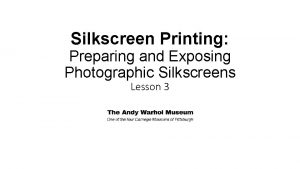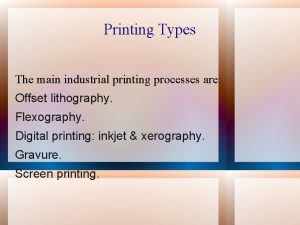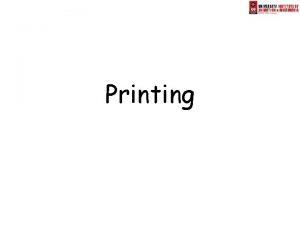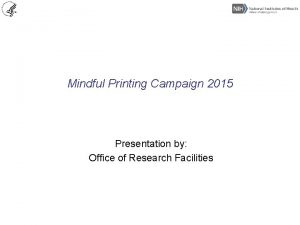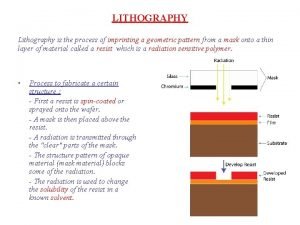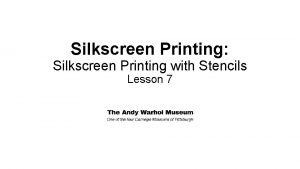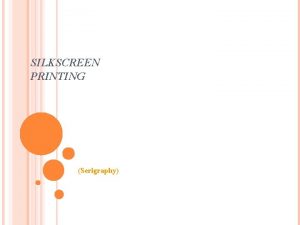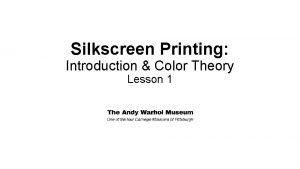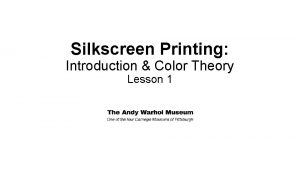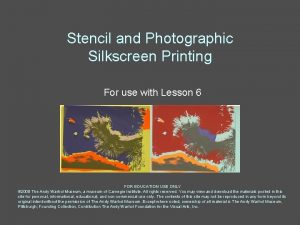Silkscreen Printing Silkscreen Printing with Stencils Lesson 7













- Slides: 13

Silkscreen Printing: Silkscreen Printing with Stencils Lesson 7

Materials • Two-inch masking tape • ¾ -inch blue painter’s tape • 10 pieces of final printing paper for each student. • Silkscreens: the exposed screen prepared in lesson 3 and 4, plus an open screen (one that has no emulsion on it) • Squeegees • Hinge clamps Inks, squeegee, spatula and tape used for silkscreen printing © The Andy Warhol Museum, one of the four Carnegie Museums of Pittsburgh. All rights reserved.

Mix all 3 colors of ink prior to printing: • mix ink in re-sealable containers. • label with name and layer number. Three containers of ink mixed by a student. Begin by taping the outer edges of the silkscreen using two-inch masking tape. Tape both sides of the silkscreen. A silkscreen that has been taped off with masking tape prior to printing. © The Andy Warhol Museum, one of the four Carnegie Museums of Pittsburgh. All rights reserved.

Place the open silkscreen in the hinge clamps, securely tightening the clamps. Photo by Sean Carroll Line up the film positive to one piece of the printing paper then secure it with pieces of blue painter’s tape. Photo by Sean Carroll © The Andy Warhol Museum, one of the four Carnegie Museums of Pittsburgh. All rights reserved.

Place the paper and film positive under the screen and register the open screen to the edges of your film positive. Use blue painter’s tape to mark the edges of the paper on the table you are printing on. This will show you where to put the paper for each print. Photo by Sean Carroll © The Andy Warhol Museum, one of the four Carnegie Museums of Pittsburgh. All rights reserved.

Carefully close the screen over the stencil paper and print the first color using enough ink for adequate coverage. Photo by Sean Carroll © The Andy Warhol Museum, one of the four Carnegie Museums of Pittsburgh. All rights reserved.

The stencil will stick to the back of the silkscreen because the ink acts as an adhesive. Starting from a top corner, slowly peel the stencil away from the screen. Paper stencil used to print a layer of purple ink Continue this process, placing each piece of paper inside the tape corners until all 10 pieces of paper are printed. Remove the stencil from the silkscreen and discard. Printed first layer of purple ink on paper © The Andy Warhol Museum, one of the four Carnegie Museums of Pittsburgh. All rights reserved.

Clean the open silkscreen and squeegee thoroughly. The two-inch tape you placed around the edges of the silkscreen should remain until you are finished printing your entire print. Photo by Sean Carroll Making sure the silkscreen is completely dry, place your taped silkscreen into the hinge clamps and securely tighten the clamps. Photo by Sean Carroll © The Andy Warhol Museum, one of the four Carnegie Museums of Pittsburgh. All rights reserved.

When Layer 1 of your print is dry, register your next stencil (Layer 2) to the film positive. Once it is in the correct place, use two small pieces of painter’s tape to secure it to the print. Remove the film positive. Repeat the printing process for layer 2 of your image. Photo by Sean Carroll Printed second layer of greenish-gold ink on paper. © The Andy Warhol Museum, one of the four Carnegie Museums of Pittsburgh. All rights reserved.

When Layer 2 of your print is dry, register your next stencil (Layer 3) to the film positive. Once it is in the correct place, use two small pieces of painter’s tape to secure it to the print. Remove the film positive. Repeat the printing process for layer 3 of your image. Photo by Sean Carroll Printed third layer of gray ink on paper. © The Andy Warhol Museum, one of the four Carnegie Museums of Pittsburgh. All rights reserved.

To print Layer 4, the final photographic image, register your film positive to your print using small pieces of painter’s tape to secure it to the print. Tape the edges of the screen with the two-inch tape on both sides (as in Step #1). Securely tighten your exposed silkscreen in the hinge clamps. Register your print to the screen and place tape marks on the corners of three edges of your paper. Remove the film positive. Photo by Sean Carroll © The Andy Warhol Museum, one of the four Carnegie Museums of Pittsburgh. All rights reserved.

Print your final layer. Clean your screen. Be sure that no ink is left in the open holes of the screen. Use the soft side of a sponge to help ease the ink out if necessary. Photo by Sean Carroll Alisha Wormsley, Unititled, 2017 Silkscreen print on paper © The Andy Warhol Museum, one of the four Carnegie Museums of Pittsburgh. All rights reserved.

Class Critique After the final silkscreen prints are dry, hang them up and conduct a class critique. Try ranking the student work as a class according to various categories and criteria learned in this unit, for example: • • Most thoughtful color scheme Best overall composition Best use of layers Best overall printmaking Finished multilayer silkscreen prints by high school students. © The Andy Warhol Museum, one of the four Carnegie Museums of Pittsburgh. All rights reserved.
